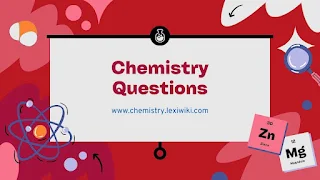Questions on Polymerization – Addition and Condensation Polymers (Organic Chemistry)
20 multiple-choice questions on Polymerization – Addition and Condensation Polymers (Organic Chemistry). Each question has five alternatives (A–E), and a complete answer key with extended explanations is provided at the end.
-- Ads --
Multiple Choice Questions: Polymerization (Addition and Condensation Polymers)
1. What is polymerization?
A) Breakdown of large molecules into smaller units
B) Process of combining monomers to form a polymer
C) Conversion of a liquid into gas
D) Removal of hydrogen atoms
E) Conversion of polymers into monomers
2. What type of monomer is required for addition polymerization?
A) Monomers with hydroxyl groups
B) Monomers with amine groups
C) Monomers with carbon-carbon multiple bonds
D) Monomers with carbonyl groups
E) Saturated hydrocarbons
3. Which of the following polymers is formed through addition polymerization?
A) Nylon
B) Polyester
C) Polyethene
D) Protein
E) Cellulose
4. What is the repeating unit in polyethene?
A) –CH=CH–
B) –CH₂–CH₂–
C) –CH₂–CHCl–
D) –C₆H₄–
E) –CO–NH–
5. Which of the following best describes condensation polymerization?
A) Monomers join by breaking double bonds
B) Monomers form polymers with no by-product
C) Monomers join with elimination of a small molecule
D) Requires UV light to initiate
E) Involves free radical chain reactions
6. What is a typical by-product of condensation polymerization?
A) CO₂
B) CH₄
C) H₂O
D) C₂H₂
E) NH₃
7. Which polymer is made by condensation polymerization?
A) Polypropene
B) Polystyrene
C) Nylon
D) Polyethene
E) PVC
8. What monomers are used to make nylon-6,6?
A) Dicarboxylic acid and diamine
B) Diol and diacid
C) Alkene and alcohol
D) Ketone and amine
E) Alkyne and ether
9. In addition polymerization, what initiates the reaction?
A) Oxygen
B) Water
C) Heat and acid
D) Free radicals
E) Ammonia
10. Which condition is necessary for free-radical polymerization?
A) Dehydration
B) Base catalysis
C) Presence of water
D) Radical initiator like benzoyl peroxide
E) Sunlight only
11. What distinguishes addition from condensation polymerization?
A) Addition requires elimination of a molecule
B) Addition polymerization requires monomers with two functional groups
C) Condensation polymerization produces no by-product
D) Condensation eliminates small molecules
E) Both only occur in gases
12. Which polymer is used to make plastic bottles and is made by condensation?
A) Polyethene
B) Nylon
C) PET (polyethylene terephthalate)
D) PVC
E) Polypropylene
13. What is the functional group in polyester?
A) –OH
B) –COOH
C) –C–O–C–
D) –COO–
E) –NH₂
14. What is the structural difference between polyethene and polystyrene?
A) Polyethene has chlorine atoms
B) Polystyrene has benzene rings as side groups
C) Polyethene is branched
D) Polystyrene is a copolymer
E) Polyethene is made by condensation
15. Which of the following is a biodegradable polymer?
A) PVC
B) Polyethene
C) Nylon
D) Polylactic acid (PLA)
E) Polystyrene
16. What is the main environmental concern with addition polymers?
A) They are acidic
B) They degrade too easily
C) They are explosive
D) They are non-biodegradable
E) They are soluble in water
17. What is a copolymer?
A) Polymer made from one type of monomer
B) Polymer made by condensation only
C) Polymer formed by mixing different polymers
D) Polymer made from two or more different monomers
E) Polymer with alternating single and triple bonds
18. Which of the following correctly matches polymer with its monomer?
A) Polyethene – ethyne
B) Nylon – amino acid
C) Polyester – ethene
D) Polypropene – propene
E) PVC – ethanoic acid
19. What is a key characteristic of monomers in condensation polymerization?
A) Must have double bonds
B) Must have at least two reactive functional groups
C) Must be gases
D) Must contain halogens
E) Must be cyclic compounds
20. What type of bond is formed during the formation of polyamides?
A) Ether
B) Ester
C) Amide
D) Alkene
E) Carbonate
- Questions about Substitution Reactions (Organic Chemistry)
- Questions on Addition Reactions (Organic Chemistry)
- Questions on Oxidation Reactions (Organic Chemistry)
✅ Answer Key with Extended Explanations
1. B – Polymerization joins monomers into polymers via chemical bonding.
2. C – Addition polymerization requires unsaturated monomers like alkenes.
3. C – Polyethene is formed from ethene by addition polymerization.
4. B – The repeating unit in polyethene is –CH₂–CH₂–.
5. C – Condensation involves elimination of a small molecule like water or methanol.
6. C – The most common by-product in condensation reactions is H₂O (water).
7. C – Nylon is made by condensation of diamine and dicarboxylic acid.
8. A – Hexanedioic acid and hexamethylenediamine form nylon-6,6.
9. D – Free radicals initiate addition polymerization in many cases.
10. D – Benzoyl peroxide is a free-radical initiator for polymerization.
11. D – Condensation polymerization eliminates small molecules like water or HCl.
12. C – PET is used in bottles and made by condensation polymerization.
13. D – Esters (–COO–) are the linkage in polyesters.
14. B – Polystyrene has phenyl groups as side chains.
15. D – PLA is a biodegradable polymer made from renewable sources.
16. D – Addition polymers like polyethene are not biodegradable, posing waste issues.
17. D – Copolymers are made from two or more different monomers.
18. D – Polypropene is made from propene via addition.
19. B – Condensation monomers must have two functional groups to form polymers.
20. C – Amide bonds link monomers in polyamides like nylon.











